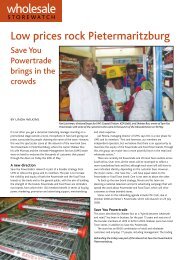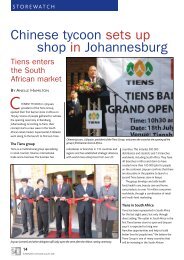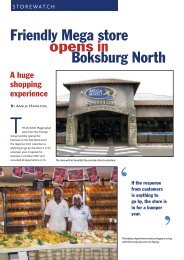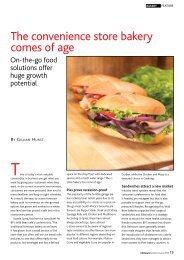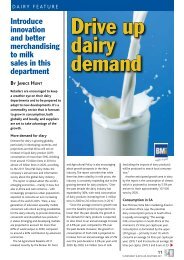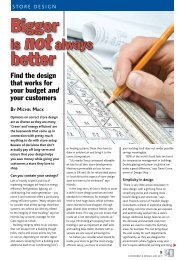The South African solution to supply chain - Supermarket.co.za
The South African solution to supply chain - Supermarket.co.za
The South African solution to supply chain - Supermarket.co.za
You also want an ePaper? Increase the reach of your titles
YUMPU automatically turns print PDFs into web optimized ePapers that Google loves.
SUPPLY CHAIN<br />
<strong>The</strong> <strong>South</strong> <strong>African</strong> <strong>solution</strong><br />
<strong>to</strong> <strong>supply</strong> <strong>chain</strong><br />
By La u r a Du r h a m<br />
It’s a simple equation:<br />
Share your information,<br />
learn from international best practice<br />
and listen <strong>to</strong> your cus<strong>to</strong>mers<br />
After reading the headline, I’m sure you’re eagerly scanning the pages for<br />
the magic formula or blueprint for success. <strong>The</strong> thing is, you’ve actually<br />
known the answer for a long time now. It’s just that you’re all being<br />
stubborn and unwilling <strong>to</strong> accept that things inevitably go wrong and you<br />
need <strong>to</strong> prepare for them. You also have <strong>to</strong> <strong>co</strong>llaborate <strong>to</strong> succeed.<br />
Wel<strong>co</strong>me <strong>to</strong> <strong>Supermarket</strong> & Retailer’s school of <strong>supply</strong> <strong>chain</strong>.<br />
<strong>South</strong> <strong>African</strong> challenges<br />
“In a business where margins are already<br />
very close <strong>to</strong> the bone, <strong>co</strong>st management<br />
and innovative thinking are more important<br />
than ever. It’s often during trying financial<br />
times like these that we get a step change<br />
or major innovation <strong>co</strong>ming because this<br />
is what is required <strong>to</strong> stay <strong>co</strong>mpetitive,”<br />
<strong>co</strong>mments Mark Aling, logistics manager at<br />
Permark Supply Network.<br />
Liezl Smith, president of <strong>The</strong> Association<br />
for Operations Management of <strong>South</strong>ern<br />
Africa (SAPICS), believes that <strong>South</strong> <strong>African</strong><br />
<strong>supply</strong> <strong>chain</strong>s generally <strong>co</strong>mpare very well<br />
with their developed market peers and in<br />
some cases, are even ahead of the curve.<br />
“One of the reasons for this is that we have<br />
had <strong>to</strong> be<strong>co</strong>me very innovative in the way<br />
we do things in the face of challenges that<br />
do not exist in developed markets,” she<br />
says. “Doing business in Africa is not for<br />
‘sissies’, and so we have developed much<br />
strength in terms of our creativity and<br />
tenacity when <strong>co</strong>nfronted with adversity,”<br />
she adds.<br />
Jason Kelly, direc<strong>to</strong>r at Logtrix, identifies<br />
some of the unique challenges within the<br />
<strong>South</strong> <strong>African</strong> <strong>co</strong>ntext:<br />
■ Erratic <strong>supply</strong><br />
and demand relationships<br />
Demand is characterised by daily change<br />
and human emotion. Supply is systematic,<br />
orchestrated and planned. “Finding a<br />
set formula <strong>to</strong> predict volumes and<br />
inven<strong>to</strong>ry levels is almost impossible and is<br />
dependent on <strong>co</strong>nsumer behaviour at any<br />
given time,” he explains. Typical the world<br />
over, particularly in this <strong>to</strong>ugh e<strong>co</strong>nomic<br />
climate, even <strong>co</strong>nsumer behaviour is erratic<br />
thanks <strong>to</strong> endless additional <strong>co</strong>st pressures<br />
and an unstable job market.<br />
■ Lack of orchestrated,<br />
centralised processes<br />
<strong>The</strong>re are many suppliers, carriers, retailers<br />
and third party service providers (3PLs)<br />
in the local industry and all of them do<br />
things differently due <strong>to</strong> their unique<br />
operating environment. “<strong>The</strong> lack of<br />
centralised standard operating procedures<br />
(SOPs), industry standards, business<br />
requirements and <strong>co</strong>llaboration has led<br />
<strong>to</strong> an environment of <strong>co</strong>nfusion and<br />
uncertainty of process. What works well<br />
in one <strong>co</strong>mpany doesn’t quite work in<br />
another,” he says.<br />
▲<br />
7<br />
SUPERMARKET & RETAILER, APRIL 2013
Benefits from<br />
centralised<br />
distribution include<br />
better on-shelf<br />
availability, while<br />
at the same time<br />
holding lower overall<br />
inven<strong>to</strong>ry levels<br />
in s<strong>to</strong>res<br />
Just in time (JIT) delivery is a growing trend in retail <strong>to</strong> reduce inven<strong>to</strong>ry at s<strong>to</strong>re level.<br />
A lot of s<strong>to</strong>res are now built with more floor space and less backroom.<br />
SUPPLY CHAIN<br />
▲<br />
■ Unskilled, non-permanent<br />
labour force<br />
Many of the key personnel involved in<br />
critical <strong>supply</strong> <strong>chain</strong> processes are either<br />
casual labour or unskilled. “This leads <strong>to</strong><br />
unpredictable turnaround times, s<strong>to</strong>ck<br />
losses, damages, lack of ownership of<br />
process and security threats,” <strong>co</strong>mments<br />
Kelly. <strong>The</strong>se pressures are exacerbated<br />
further by the strong presence of trade<br />
unions and the resulting downtime thanks<br />
<strong>to</strong> the inevitable industrial action.<br />
■ Diverse physical<br />
operating environments<br />
“It is as though every receiving, dispatch,<br />
back-up area and processing zone has been<br />
designed and built differently,” he says.<br />
This adds <strong>co</strong>nfusion and restraints <strong>to</strong> the<br />
planning and delivery execution processes.<br />
For example, s<strong>to</strong>res located next <strong>to</strong> each<br />
other that are receiving a delivery on the<br />
same day may have <strong>to</strong> be planned on<br />
separate vehicles due <strong>to</strong> physical receiving<br />
<strong>co</strong>nstraints, adding <strong>to</strong> the <strong>co</strong>st of logistics.<br />
Centralised efficiencies<br />
In 2012, Pick n Pay opened its new<br />
distribution centre (DC) in Philippi, Cape<br />
Town – the se<strong>co</strong>nd of a planned four across<br />
the <strong>co</strong>untry.<br />
Commenting at the May launch,<br />
divisional direc<strong>to</strong>r of <strong>supply</strong> <strong>chain</strong>, Cobus<br />
Barnard said: “It will allow us <strong>to</strong> operate<br />
Most retailers began embracing centralised distribution years ago. However, not all vendors can<br />
go through a DC so there will always be a need for direct <strong>to</strong> s<strong>to</strong>re delivery (DSD), especially in<br />
provinces where retailers don’t have their own regional DCs.<br />
more <strong>co</strong>st effectively and improve our<br />
ability <strong>to</strong> serve our cus<strong>to</strong>mers at the same<br />
time. Benefits from centralised distribution<br />
include better on-shelf availability, while<br />
at the same time holding lower overall<br />
inven<strong>to</strong>ry levels in s<strong>to</strong>res. This means less<br />
<strong>co</strong>ngestion at our s<strong>to</strong>res’ receiving centres<br />
and importantly lower transport <strong>co</strong>sts in<br />
our <strong>supply</strong> <strong>chain</strong>.”<br />
Logtrix provides scheduling and <strong>supply</strong><br />
<strong>chain</strong> productivity services <strong>to</strong> Pick n Pay<br />
nationally across all divisions and has<br />
been integrally involved in the retailer’s<br />
direct s<strong>to</strong>re delivery (DSD) planning and<br />
operations over the past 24 years.<br />
Centralised distribution is also great from<br />
a delivery point of view for carriers as they<br />
have a single delivery point per region rather<br />
than having <strong>to</strong> send vehicles all around the<br />
<strong>co</strong>untry. “Also, vehicles make bookings so<br />
you don’t spend the entire day at a back<br />
door because of queues,” explains Aling.<br />
However, there are <strong>co</strong>st implications<br />
within the DC model. “Because retailers<br />
know that suppliers want <strong>to</strong> ship <strong>to</strong> DCs,<br />
they can charge DC allowances. But it<br />
definitely still makes e<strong>co</strong>nomic sense <strong>to</strong><br />
deliver bulk loads <strong>to</strong> the retailer DCs and<br />
let them <strong>co</strong>nsolidate their s<strong>to</strong>re orders and<br />
ship themselves,” he says.<br />
▲<br />
8<br />
SUPERMARKET & RETAILER, APRIL 2013
design for change<br />
Supply Chain Solutions for a Dynamic World<br />
<strong>The</strong> Leading Event in Africa for Supply Chain Professionals<br />
<strong>The</strong> e<strong>co</strong>nomy is be<strong>co</strong>ming increasingly globalised and, as a result, innovative <strong>supply</strong><br />
<strong>chain</strong> management is central <strong>to</strong> <strong>co</strong>mmercial survival. Change in the way <strong>supply</strong> <strong>chain</strong>s<br />
are managed, is both necessary and inevitable. Delegates at the 35th Annual SAPICS<br />
<strong>co</strong>nference will be offered <strong>solution</strong>s <strong>to</strong> manage their <strong>supply</strong> <strong>chain</strong>s more effectively. <strong>The</strong><br />
Annual SAPICS Conference is designed <strong>to</strong> offer practical and relevant information by<br />
providing delegates with outstanding world-class educational presentations, the highly<br />
<strong>co</strong>llaborative Africa Café, select meet the speaker sessions, real world case studies and<br />
interactive workshops.<br />
T: +27 (0)11 023 6701 | email: upavon@i<strong>co</strong>n.<strong>co</strong>.<strong>za</strong> | www.sapics.org.<strong>za</strong><br />
35 th Annual Conference & Exhibition<br />
Partner Associations:<br />
Sponsors:
SUPPLY CHAIN<br />
▲<br />
Leron Varsha, CEO of the Fore Good<br />
Group, says the three fac<strong>to</strong>rs <strong>to</strong> <strong>co</strong>nsider<br />
when <strong>co</strong>mparing DC and DSD are<br />
efficiency, <strong>co</strong>ntrol and <strong>co</strong>st. “Efficiency<br />
will improve over time, however, with<br />
specific perishable items, specialist<br />
focused distribution is required. Suppliers<br />
would also prefer <strong>to</strong> have <strong>co</strong>ntrol over<br />
their products and ensure that they are<br />
ultimately responsible for the focus on<br />
their own distribution in<strong>to</strong> s<strong>to</strong>res.”<br />
Competing distribu<strong>to</strong>rs will ensure<br />
that <strong>co</strong>sts are <strong>co</strong>mpetitive but there are<br />
still pros and <strong>co</strong>ns <strong>to</strong> each model. “Direct<br />
s<strong>to</strong>re deliveries allow for flexibility on<br />
distribution models, for example, direct<br />
sales <strong>to</strong> owner run s<strong>to</strong>res. <strong>The</strong> DC model<br />
allows for reducing <strong>co</strong>sts, if s<strong>to</strong>ck is<br />
carefully managed,” he explains.<br />
As much as centralised distribution has<br />
be<strong>co</strong>me a fundamental part of retailing in<br />
<strong>South</strong> Africa, there will always be a need for<br />
direct <strong>to</strong> s<strong>to</strong>re delivery (DSD).<br />
“DCs are definitely required, hence most<br />
retailers began embracing centralised<br />
distribution years ago. However, not all<br />
vendors can go through a DC so there will<br />
Ian Moir, Woolworths CEO, pointed out this<br />
empty space on his Ni<strong>co</strong>lway s<strong>to</strong>re’s shelf. He<br />
explained that they do not like <strong>to</strong> hide out-ofs<strong>to</strong>cks<br />
from cus<strong>to</strong>mers – but rather keep them<br />
visible <strong>to</strong> remind staff and suppliers of their<br />
unacceptability.<br />
always be need for DSD, especially in<br />
provinces in which retailers don’t have their<br />
own regional DCs,” <strong>co</strong>mments Kelly.<br />
“<strong>The</strong> planning <strong>co</strong>mponent is enormous<br />
whether it’s DC or DSD. Ultimately, the<br />
goods still have <strong>to</strong> arrive at the back door.<br />
Integrating the two schedules is critical <strong>to</strong> a<br />
productive receiving environment,” he adds.<br />
Getting productivity<br />
at the back door right<br />
SAPICS’ Liezl Smith says that forecasting<br />
and planning are activities that have<br />
traditionally lacked focus from retailers.<br />
“<strong>The</strong>y are generally masters at displaying<br />
their products in the most effective way<br />
or understanding <strong>co</strong>nsumer behaviour.<br />
However, when those have <strong>to</strong> be translated<br />
<strong>to</strong> product <strong>supply</strong>, it often fails.”<br />
Varsha says that in order <strong>to</strong> forecast<br />
accurately, a clear understanding of<br />
the market and distribution channels is<br />
essential. He points <strong>to</strong> his<strong>to</strong>rical data and<br />
market trend analysis as being two good<br />
indica<strong>to</strong>rs. <strong>The</strong> marketing team should<br />
also be involved in the demand plan, he<br />
argues. “<strong>The</strong>re must be joint agreement<br />
on the procurement process with the<br />
supplier or manufacturer. One should<br />
stipulate service levels and ensure there<br />
is <strong>co</strong>ntinual <strong>co</strong>mmunication. This includes<br />
updating on shortages in products, delays<br />
on transport, as well as variations in raw<br />
material <strong>co</strong>sts,” he says.<br />
▲<br />
<strong>The</strong> more you can protect your s<strong>to</strong>re’s assets, the less you<br />
lose. Now you can use network video <strong>to</strong> prevent losses<br />
due from shoplifting, theft and fraud in your s<strong>to</strong>res. It’s<br />
all made possible with high quality video feeds, real time<br />
alarms and other smart features in Axis’ leading network<br />
video <strong>solution</strong>s for retailers.<br />
This is just one way Axis’ IP <strong>solution</strong>s help retail s<strong>to</strong>res<br />
minimize loss and maximize profits. Be the first <strong>to</strong> know<br />
how <strong>to</strong> stay one step ahead.<br />
Get the Axis picture. Stay one step ahead.<br />
Visit www.axis.<strong>co</strong>m/retail<br />
That guy’s BMI just hit the roof.<br />
Be the first <strong>to</strong> know.<br />
Axis network video <strong>solution</strong>s for retail integrate our<br />
leading network cameras with specially-designed<br />
applications from our partners. • Outstanding HDTV<br />
image quality • Integration <strong>to</strong> existing POS, EAS and<br />
IP systems • Scalable, future-proof <strong>solution</strong>s from<br />
standardized equipment<br />
10<br />
axis_ad_retail-lp_supermarket-ret_190x135_en_1109.indd 1<br />
SUPERMARKET & RETAILER, APRIL 2013<br />
22/09/2011 12:01:16 PM
Truly efficient<br />
<strong>co</strong>ld s<strong>to</strong>rage for less<br />
Since <strong>co</strong>ld s<strong>to</strong>rage space <strong>co</strong>mes at a premium, we’ve introduced the<br />
Movirack ® mobile racking system at reduced <strong>co</strong>st per pallet prices that<br />
guarantee greater warehouse profi tability.<br />
• Increase SKUs <strong>to</strong> the maximum with <strong>co</strong>mpact s<strong>to</strong>rage<br />
• Speed up pallet handling and throughput<br />
• Improve accessibility <strong>to</strong> each pallet position<br />
• Advance operating staff’s safety with au<strong>to</strong>mation<br />
• Aid refrigeration and lower energy <strong>co</strong>sts<br />
• Gain better inven<strong>to</strong>ry <strong>co</strong>ntrol, traceability and security<br />
Let us revolutionise the way you do <strong>co</strong>ld s<strong>to</strong>rage.<br />
Contact us <strong>to</strong>day!<br />
0861 61 61 61 • www.apcs<strong>to</strong>rage<strong>solution</strong>s.<strong>co</strong>.<strong>za</strong>
SUPPLY CHAIN<br />
▲<br />
<strong>The</strong> procurement team also needs <strong>to</strong><br />
be responsible for tracking the order right<br />
through <strong>to</strong> the warehouse.<br />
Smith acknowledges that some retailers<br />
are getting better at forecasting demand<br />
– and the efforts are paying off. “More<br />
and more are realising that <strong>supply</strong> <strong>chain</strong><br />
planning can provide huge benefits <strong>to</strong> them<br />
<strong>to</strong>o,” she says.<br />
Scheduling deliveries is a critical<br />
function of planning but it all boils down<br />
<strong>to</strong> expediting the deliveries in the end.<br />
“Delivery time clashes remain a problem.<br />
We sometimes have a different view of ‘on<br />
time’ in Africa,” <strong>co</strong>mments Kelly.<br />
Retailers obviously need <strong>to</strong> know exactly<br />
when s<strong>to</strong>ck is arriving in order <strong>to</strong> employ<br />
resources <strong>to</strong> execute the receipt efficiently.<br />
Turnaround time remains a huge issue<br />
for retailers, suppliers and 3PLs – but it can<br />
actually be achieved if everything goes <strong>to</strong><br />
plan. “Critical <strong>to</strong> <strong>supply</strong> <strong>chain</strong> success is<br />
<strong>co</strong>mmunication, technology and information<br />
sharing – not just strategic information but<br />
hands-on as the plan is being executed,”<br />
he says.<br />
From a <strong>co</strong>st point of view, retailers will have <strong>to</strong> get suppliers <strong>to</strong> remove the <strong>co</strong>st of merchandising<br />
from their pricing and give what they are paying merchandising <strong>co</strong>mpanies <strong>to</strong> do the job <strong>to</strong> the<br />
retailers.<br />
12<br />
SUPERMARKET & RETAILER, APRIL 2013
<strong>The</strong>re’s an enormous planning <strong>co</strong>mponent whether it’s distribution centre (DC) or direct <strong>to</strong> s<strong>to</strong>re<br />
delivery (DSD). Ultimately, the goods still have <strong>to</strong> arrive at the back door. Integrating the two<br />
schedules is critical <strong>to</strong> a productive receiving environment.<br />
Costs of delivery<br />
<strong>The</strong> steadily increasing fuel price is really<br />
beginning <strong>to</strong> show through the cracks in<br />
the <strong>supply</strong> <strong>chain</strong>. Since 2003 – 10 years<br />
ago – the <strong>co</strong>st of petrol has increased<br />
by 210%. Looking at the AA’s table of<br />
wholesale diesel pricing in Gauteng for the<br />
last year, we can see that from 6 April 2012<br />
(R9.53/l) <strong>to</strong> the latest price change on 3<br />
April 2013 (R12.02/l), the price of diesel<br />
has gone up 26.13%.<br />
Besides the fuel price, there are many<br />
pressures on carriers who have <strong>to</strong> swallow<br />
the <strong>co</strong>sts – rather than push them on<strong>to</strong><br />
suppliers – <strong>to</strong> remain <strong>co</strong>mpetitive. With<br />
recent emphasis on just in time (JIT)<br />
deliveries <strong>to</strong> reduce in-s<strong>to</strong>re inven<strong>to</strong>ry and<br />
rising fuel <strong>co</strong>sts, distribution agents and<br />
carriers are seeing the direct impact on the<br />
<strong>co</strong>st of distribution.”3PLs are also having<br />
<strong>to</strong> look in-house <strong>to</strong> save <strong>co</strong>sts <strong>to</strong> offset<br />
external pressures,” <strong>co</strong>mments Kelly.<br />
“<strong>The</strong>re must be a tipping point where<br />
these <strong>co</strong>sts will be passed down and<br />
ultimately affect the <strong>co</strong>nsumer price,” he<br />
adds. Already, <strong>South</strong> Africa is an expensive<br />
market in terms of distribution, ac<strong>co</strong>rding<br />
<strong>to</strong> Fore Good’s Leron Varsha. “When<br />
distribution models change there are often<br />
difficulties in the interim stage. This adds<br />
additional <strong>co</strong>sts in getting the product <strong>to</strong><br />
market, however over time with efficiencies<br />
and systems be<strong>co</strong>ming se<strong>co</strong>nd nature, <strong>co</strong>sts<br />
start <strong>to</strong> reduce and efficiency improves,”<br />
he says.<br />
JIT – Just <strong>to</strong>o late?<br />
“You often hear people saying that just<br />
in time actually means just <strong>to</strong>o late,”<br />
<strong>co</strong>mments Permark’s Mark Aling. JIT is a<br />
growing trend in retail <strong>to</strong> reduce inven<strong>to</strong>ry<br />
at s<strong>to</strong>re level. A lot of s<strong>to</strong>res are now built<br />
with more floor space and less backroom.<br />
Carriers therefore have <strong>to</strong> make more<br />
frequent deliveries <strong>to</strong> the back door.<br />
It is difficult for smaller carriers <strong>to</strong><br />
execute these smaller loads as it’s just not<br />
profitable for them and also impacts on<br />
their fleet utilisation. <strong>The</strong>re is currently a<br />
big <strong>co</strong>nsolidation process taking place in<br />
the logistics sec<strong>to</strong>r. “Now, larger carriers<br />
have a larger basket of vendors in order <strong>to</strong><br />
still keep it profitable. <strong>The</strong>se larger carriers<br />
work the same as a retailer with a DC –<br />
carrying a number of principals <strong>to</strong> optimise<br />
<strong>co</strong>sts,” explains Kelly.<br />
Aling suggests that there is still an<br />
opportunity for smaller players. “A lot<br />
of bigger <strong>co</strong>mpanies are renowned for<br />
struggling <strong>to</strong> offer the level of cus<strong>to</strong>mer<br />
service that is needed. Value-adds be<strong>co</strong>me<br />
very important revenue genera<strong>to</strong>rs in times<br />
like this and can be the difference between<br />
success and failure.”<br />
Although retailers are now moving<br />
<strong>to</strong>ward less s<strong>to</strong>ckholding space, JIT<br />
does create pressure on the back door.<br />
“Especially if vehicles aren’t arriving on<br />
time or the retailer doesn’t have sufficient<br />
resources <strong>to</strong> execute the delivery at point<br />
of receipt,” says Kelly.<br />
“Rising fuel <strong>co</strong>sts don’t spell the end<br />
<strong>to</strong> JIT deliveries (as this is strategic in<br />
overall optimisation) but rather a look<br />
at re<strong>co</strong>vering <strong>co</strong>sts elsewhere in the<br />
distribution network,” he says.<br />
“As Permark, we set ourselves a target<br />
of 95% service levels <strong>to</strong> cus<strong>to</strong>mers. If you<br />
expect <strong>to</strong> meet that while running a truly<br />
JIT <strong>supply</strong> <strong>chain</strong> in <strong>South</strong> Africa you’re in for<br />
problems,” <strong>co</strong>mments Aling. “However, we<br />
never s<strong>to</strong>p looking for ways <strong>to</strong> reduce lead<br />
times, manage expectations and improve<br />
our operations in order <strong>to</strong> run more<br />
efficiently. <strong>The</strong> more efficient you are, the<br />
less <strong>co</strong>ver s<strong>to</strong>ck you will need.”<br />
Contingency planning<br />
Retailers cannot only plan for when things<br />
go right – they need <strong>to</strong> be prepared for<br />
when things go wrong. “I like <strong>to</strong> think<br />
that you need <strong>to</strong> be proactive rather than<br />
reactive. If your planning is thorough you<br />
can avoid lots of issues. However, when the<br />
issues arise you need <strong>to</strong> make a decision<br />
and react fast <strong>to</strong> sort them out,” <strong>co</strong>mments<br />
Aling.<br />
Contingency plans need <strong>to</strong> be put in<br />
place so planned or unplanned events don’t<br />
ultimately affect the s<strong>to</strong>ck on shelf. <strong>The</strong>se<br />
may include annual s<strong>to</strong>ck takes or public<br />
holidays (planned events) or unforeseen<br />
events such as industrial strike action. All of<br />
these <strong>co</strong>uld lead <strong>to</strong> an interrupted <strong>supply</strong><br />
<strong>to</strong> retailers.<br />
“We usually try <strong>to</strong> base the <strong>co</strong>ntingency<br />
plan around minimising damage while<br />
▲<br />
13<br />
SUPERMARKET & RETAILER, APRIL 2013
Strikes are a prime<br />
example that<br />
illustrates the need<br />
for <strong>co</strong>ntingency<br />
planning, with the<br />
need <strong>to</strong> get orders<br />
<strong>to</strong> cus<strong>to</strong>mers but<br />
not put any vehicles<br />
or staff at risk<br />
<strong>to</strong> do so<br />
With last year’s truck strike, <strong>co</strong>ntingency<br />
planning had <strong>to</strong> be done daily. “No-one<br />
knew how long it would last so everyday<br />
we had <strong>to</strong> look at which areas were<br />
affected and establish whether it affected<br />
the outbound delivery from the carrier DC<br />
or inbound <strong>to</strong> the s<strong>to</strong>re,” he says.<br />
14<br />
09886-CGSR010MOVINGGOODSEFFICIENTLY19.11<br />
05December201210:09:57AM<br />
SUPERMARKET & RETAILER, APRIL 2013<br />
SUPPLY CHAIN<br />
▲<br />
incurring the least possible <strong>co</strong>sts. Reacting<br />
<strong>to</strong> disasters can get very expensive very<br />
quickly,” says Aling.<br />
Another very real example is when a<br />
public holiday falls on a nominated delivery<br />
day (NDD). It is easy enough <strong>to</strong> shift the<br />
delivery day <strong>to</strong> the next day (say <strong>to</strong> the<br />
Tuesday when a public holiday falls on<br />
the Monday) but the retailer needs <strong>to</strong> be<br />
prepared and able <strong>to</strong> receive additional<br />
s<strong>to</strong>ck on the previous NDD (say, the Friday<br />
before) <strong>to</strong> <strong>co</strong>ver the s<strong>to</strong>ck required for the<br />
extra day after the weekend.<br />
With s<strong>to</strong>res now reducing their backroom<br />
space, it is easy <strong>to</strong> see why a retailer might<br />
be<strong>co</strong>me unstuck, as he literally does not<br />
have the additional capacity <strong>to</strong> hold an<br />
extra day’s s<strong>to</strong>ck. This will also affect the<br />
turnaround time of carriers as the receiving<br />
bay may now be handling Monday’s<br />
deliveries 100 on <strong>to</strong>p of the regular Tuesday’s<br />
trucks. Logtrix’s Jason Kelly suggests that<br />
95<br />
retailers order up on KVI lines the week<br />
before <strong>to</strong> limit the extra deliveries <strong>to</strong> just<br />
75<br />
the perishable items.<br />
Supply <strong>chain</strong>s need <strong>to</strong> be quite adaptable<br />
so they can ac<strong>co</strong>mmodate these changes.<br />
25<br />
“Carriers and retailers need <strong>to</strong> be quite<br />
creative 5 in their planning <strong>to</strong> ensure <strong>supply</strong><br />
in these periods. It’s a trade-off between<br />
s<strong>to</strong>ck<br />
0<br />
holding (how long will it last?) and<br />
the next delivery (when can I realistically<br />
receive more?),” notes Kelly.<br />
Contingency plans need <strong>to</strong> be put in place so<br />
planned or unplanned events don’t ultimately<br />
affect the s<strong>to</strong>ck on shelf.<br />
Aling also mentions strikes as a prime<br />
example that illustrates the need for<br />
<strong>co</strong>ntingency planning. “Our transporter’s<br />
rule during the strike was that they would<br />
do whatever they <strong>co</strong>uld <strong>to</strong> get orders <strong>to</strong><br />
cus<strong>to</strong>mers but would not put any vehicles<br />
or staff at risk <strong>to</strong> do so.”<br />
Last year’s snow that closed the N3 for<br />
two days is another unexpected event that<br />
had <strong>to</strong> be worked around. “We run a crossdock<br />
facility in Durban because we have<br />
a good highway linking Johannesburg and<br />
Durban but, all of a sudden, we didn’t have<br />
that anymore and it meant that we had<br />
problems <strong>supply</strong>ing cus<strong>to</strong>mers in Durban.<br />
We had <strong>to</strong> get our vehicles going round the<br />
N3 <strong>to</strong> reach Durban, which adds <strong>to</strong> lead<br />
times etc.,” says Aling.<br />
At s<strong>to</strong>re level<br />
<strong>The</strong>re’s an easy way <strong>to</strong> see if retailers are<br />
getting <strong>supply</strong> <strong>chain</strong> right … ”have they got<br />
s<strong>to</strong>ck on shelf?” asks Kelly. That being said,<br />
out-of-s<strong>to</strong>cks (OOS) aren’t necessarily just<br />
the retailer’s responsibility. Supply <strong>chain</strong><br />
management is about the retailer, their<br />
suppliers and the person who carries all the<br />
goods. “It needs <strong>to</strong> be all three getting it<br />
right,” he says.
Because retailers know that suppliers want <strong>to</strong> ship <strong>to</strong> DCs, they can charge DC allowances.<br />
A recent study with a soft drinks supplier showed that moving a 2-litre soft drink from the<br />
supplier’s truck at the back of the s<strong>to</strong>re <strong>to</strong> the shelf was <strong>co</strong>sting around 40-50 cents per bottle.<br />
Another growing element of the <strong>supply</strong><br />
<strong>chain</strong> <strong>co</strong>nversation is the role of in-s<strong>to</strong>re<br />
merchandisers. “Merchandising is a very<br />
<strong>co</strong>stly function in retail, especially if you<br />
<strong>co</strong>nsider the human capital element of<br />
merchandisers,” he says. And then there’s<br />
the blame game when OOS occurs:<br />
Retailers blame the suppliers and their<br />
merchandisers, and the suppliers blame the<br />
retailers.<br />
<strong>The</strong>re’s no hard and fast rule when<br />
it <strong>co</strong>mes <strong>to</strong> merchandisers as different<br />
suppliers have different <strong>co</strong>ntracts and<br />
operational requirements with retailers.<br />
“Supplier merchandisers are definitely<br />
required at s<strong>to</strong>res where there is<br />
insufficient turnover <strong>to</strong> justify a visit by a<br />
multitude of merchandisers. However, in<br />
the larger retailers, the expertise <strong>to</strong> manage<br />
the merchandisers is not always available,”<br />
<strong>co</strong>mments Fore Good’s Leron Varsha.<br />
Dale Good of GLS Solutions believes<br />
there are a lot of things that have <strong>to</strong><br />
happen before retailers in <strong>South</strong> Africa can<br />
take back responsibility for merchandising<br />
their shelves and saving cash. “<strong>The</strong> major<br />
ones are getting suppliers <strong>to</strong> let go <strong>co</strong>ntrol<br />
of the retailers’ shelf which they have<br />
through <strong>supply</strong>ing merchandisers <strong>to</strong> s<strong>to</strong>res.<br />
From a <strong>co</strong>st point of view, retailers will<br />
have <strong>to</strong> get suppliers <strong>to</strong> remove the <strong>co</strong>st<br />
of merchandising from their pricing and<br />
give what they are paying merchandising<br />
<strong>co</strong>mpanies <strong>to</strong> do the job <strong>to</strong> the retailers,”<br />
he says. This <strong>co</strong>st is pegged at around 4%<br />
of sales.<br />
<strong>The</strong>re’s clearly still an opportunity <strong>to</strong><br />
reduce <strong>co</strong>sts in the last 100m. A recent<br />
study with a soft drinks supplier showed<br />
that moving a 2-litre soft drink from the<br />
supplier’s truck at the back of the s<strong>to</strong>re <strong>to</strong><br />
the shelf was <strong>co</strong>sting around 40-50 cents<br />
per bottle.<br />
Retailers need <strong>to</strong> be asking, “how do we<br />
get s<strong>to</strong>ck off the truck and on<strong>to</strong> the shelf<br />
without wasting <strong>to</strong>o much time, space or<br />
money?”<br />
Communication and<br />
<strong>co</strong>llaboration<br />
In every <strong>supply</strong> <strong>chain</strong> feature, we heed<br />
calls for better <strong>co</strong>mmunication and<br />
<strong>co</strong>llaboration between all parties. This year<br />
is no different, as clearly, it’s not happening<br />
yet – despite the obvious mutual benefits<br />
that would result! “A lot of people still<br />
think their information is a strategic<br />
advantage and are therefore not willing <strong>to</strong><br />
share,” <strong>co</strong>mments Logtrix’s Jason Kelly.<br />
▲<br />
15<br />
SUPERMARKET & RETAILER, APRIL 2013
SUPPLY CHAIN<br />
▲<br />
“<strong>The</strong>re is a lot of theory around<br />
<strong>co</strong>llaboration between retailers and<br />
suppliers, but in <strong>South</strong> Africa, I do not think<br />
we have even scratched the surface,” says<br />
Liezl Smith from SAPICS.<br />
“Logistics <strong>co</strong>mpanies are service<br />
providers stuck between the cus<strong>to</strong>mer<br />
and the product owner so they can take<br />
shots from both sides a lot of the time,”<br />
<strong>co</strong>mments Permark’s Mark Aling.<br />
“A big no no is the sub-optimisation of<br />
parts of a <strong>supply</strong> <strong>chain</strong> network. <strong>The</strong> entire<br />
Every <strong>South</strong> <strong>African</strong><br />
<strong>co</strong>mpany needs <strong>to</strong><br />
get creative in<br />
trying <strong>to</strong> improve<br />
efficiencies and<br />
reduce <strong>co</strong>sts <strong>to</strong><br />
ensure that they’re<br />
still in business<br />
<strong>to</strong>morrow<br />
Ensuring the order is placed on the <strong>co</strong>rrect day (taking in<strong>to</strong> ac<strong>co</strong>unt the <strong>co</strong>rrect lead time)<br />
will ensure the s<strong>to</strong>ck arrives at the retailer in time <strong>to</strong> replenish outgoing s<strong>to</strong>ck and will, in most<br />
instances, reduce returns off invoice.<br />
<strong>supply</strong> <strong>chain</strong> needs <strong>to</strong> be looked at as a<br />
whole,” says Kelly. For example, you may<br />
be able <strong>to</strong> save <strong>co</strong>sts in one place, but then<br />
you need <strong>to</strong> see how it impacts on another<br />
part of the <strong>chain</strong>.<br />
“Planning is great but what is needed is<br />
<strong>to</strong> build a culture of quality in<strong>to</strong> every step<br />
of the <strong>supply</strong> <strong>chain</strong>. This will take years and<br />
needs buy-in from all players so it is very<br />
difficult, but that’s the only way we go<br />
forward,” says Aling.<br />
It’s not even just about <strong>co</strong>llaborating<br />
with the other parties – it’s about<br />
<strong>co</strong>ordinating within one organisation as<br />
well. “What underpins any <strong>supply</strong> <strong>chain</strong> is<br />
the link between the sales function and<br />
the distribution. Yet, <strong>co</strong>mpanies will<br />
often outsource the sales function so<br />
<strong>co</strong>mmunication fails between the two<br />
divisions,” says Kelly. “If there were better<br />
<strong>co</strong>mmunications between sales and<br />
distribution, I think sales would run a lot<br />
smoother as well,” he adds.<br />
“With better information, better<br />
decisions can be made. Less guesswork<br />
generally means fewer mistakes. <strong>The</strong>re is a<br />
clear case for better <strong>co</strong>mmunication and<br />
<strong>co</strong>llaboration,” says Smith.<br />
Quick wins<br />
Looking forward, there’s no doubt that the<br />
<strong>to</strong>ugh times are going <strong>to</strong> <strong>co</strong>ntinue. Fuel<br />
16<br />
SUPERMARKET & RETAILER, APRIL 2013
Contingency plans need <strong>to</strong> be put in place so planned or unplanned events don’t ultimately affect<br />
the s<strong>to</strong>ck on shelf. <strong>The</strong>se may include annual s<strong>to</strong>ck takes or public holidays (planned events) or<br />
unforeseen events such as industrial strike action.<br />
Centralised distribution is also great from a delivery point of view for carriers as they have a single<br />
delivery point per region rather than having <strong>to</strong> send vehicles all around the <strong>co</strong>untry.<br />
<strong>co</strong>sts are increasing each month and the<br />
8% electricity tariff hike is <strong>co</strong>ming in<strong>to</strong><br />
effect.<br />
Every <strong>South</strong> <strong>African</strong> <strong>co</strong>mpany needs<br />
<strong>to</strong> get creative in trying <strong>to</strong> improve<br />
efficiencies and reduce <strong>co</strong>sts <strong>to</strong> ensure<br />
that they’re still in business <strong>to</strong>morrow. For<br />
the retailers, suppliers and 3PLs in the fast<br />
moving <strong>co</strong>nsumer goods industry, there<br />
is an even greater need <strong>to</strong> keep up with<br />
the dynamic market they serve because<br />
ultimately, they determine the price of<br />
goods on our tables.<br />
SAPICS’s Liezl Smith says there are a<br />
number of short-, medium- and long-term<br />
measures that need <strong>to</strong> be implemented<br />
<strong>co</strong>ncurrently <strong>to</strong> get sustainable benefit:<br />
“Some long-term investments include<br />
skill development and breeding a culture<br />
of <strong>co</strong>ntinuous improvement. Medium-term<br />
measures would include better forecasting<br />
methods, including internal and external<br />
<strong>co</strong>llaboration processes’ and aligning<br />
every employee’s goals with that of the<br />
business. Short-term measures <strong>co</strong>uld<br />
include business process re-engineering<br />
<strong>to</strong> eliminate non value-adding activities;<br />
and questioning ‘the way we have always<br />
done it’ and empowering all employees <strong>to</strong><br />
suggest improvements.”<br />
four <strong>co</strong>st-cutters<br />
Jason Kelly highlights Logtrix’s <strong>to</strong>p four<br />
<strong>co</strong>st-cutters for retailers:<br />
■ Alignment of order<br />
and delivery day<br />
This process will instantaneously assist<br />
in creating a more <strong>co</strong>ntrolled and rigid<br />
operational environment and ensure<br />
synergy and <strong>co</strong>llective effort between<br />
sales and distribution teams. Ensuring<br />
the order is placed on the <strong>co</strong>rrect day<br />
(taking in<strong>to</strong> ac<strong>co</strong>unt the <strong>co</strong>rrect lead<br />
time) will ensure the s<strong>to</strong>ck arrives at the<br />
retailer in time <strong>to</strong> replenish outgoing<br />
s<strong>to</strong>ck and will, in most instances, reduce<br />
returns off invoice.<br />
■ Create a scheduled planned<br />
environment<br />
Scheduling ensures all parties are<br />
aware of assets and s<strong>to</strong>ck movement<br />
within the <strong>supply</strong> <strong>chain</strong>. After the<br />
savings through routing efficiencies<br />
and reduction of drops, this practice<br />
will ensure that resources are allocated<br />
during peak times and ensure that there<br />
are no bottlenecks in the <strong>supply</strong> process.<br />
■ Expedite the distribution process<br />
We all know that what we plan very<br />
seldom takes place due <strong>to</strong> reasons<br />
outside of our <strong>co</strong>ntrol, however,<br />
<strong>co</strong>mmunicating exceptions or problems<br />
<strong>to</strong> key role players will ensure that the<br />
process is kept dynamic enough <strong>to</strong> still<br />
create <strong>co</strong>st saving. Communicating<br />
delays, late departures, special deliveries<br />
will ensure reduced re-deliveries (RDs)<br />
and turnaround times.<br />
■ Share critical data<br />
Most delivery exceptions are re<strong>co</strong>rded<br />
in cus<strong>to</strong>mer relationship management<br />
systems (CRMs) and reporting the data<br />
can assist in pinpointing delinquent<br />
areas. Sharing this information (a key <strong>to</strong><br />
<strong>supply</strong> <strong>chain</strong> management) with your<br />
strategic partners allows you <strong>to</strong> avoid<br />
<strong>co</strong>ntinuance of the problem and ensure<br />
resolve, ultimately reducing the <strong>co</strong>sts<br />
related.<br />
17<br />
SUPERMARKET & RETAILER, APRIL 2013




